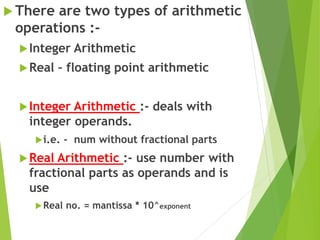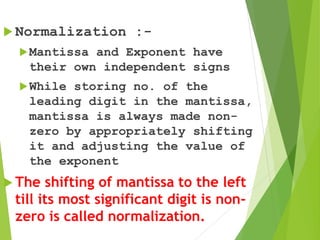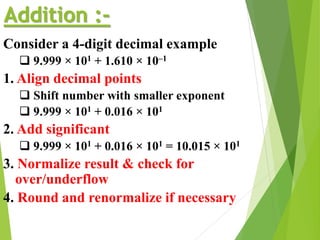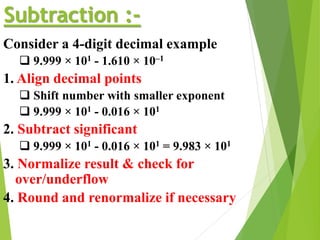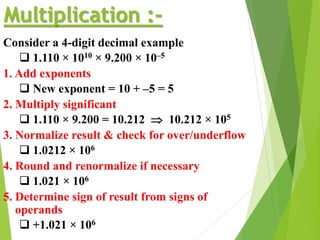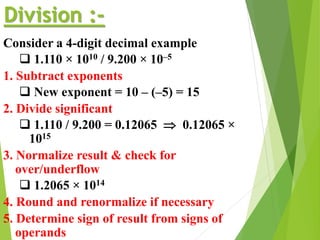CBNST PPT, Floating point arithmetic,Normalization
- 1. ’ü▒Floating point arithmetic ’ü▒Representation of floating point arithmetic ’ü▒Operations ’ü▒Normalization ’ü▒Pit-Falls of floating point arithmetic
- 2. ’üĄ There are two types of arithmetic operations :- ’üĄInteger Arithmetic ’üĄReal ŌĆō floating point arithmetic ’üĄInteger Arithmetic :- deals with integer operands. ’üĄi.e. - num without fractional parts ’üĄReal Arithmetic :- use number with fractional parts as operands and is use ’üĄReal no. = mantissa * 10^exponent
- 3. COMPUTER REPRESENTATION OF FLOATING POINT NUMBERS In the CPU, a 32-bit floating point number is represented using IEEE standard format as follows: S | EXPONENT | MANTISSA where S is one bit, the EXPONENT is 8 bits, and the MANTISSA is 23 bits.
- 4. ’āś The mantissa ’āś represents the leading significant bits in the number. ’āś It is made less than 1 and greater than or equal to 0.1 ’āś The exponent ’āś is used to adjust the position of the binary point (as opposed to a "decimal" point) ’āś In power of 10 and multiplies with mantissa
- 5. ’üĄ Normalization :- ’üĄMantissa and Exponent have their own independent signs ’üĄWhile storing no. of the leading digit in the mantissa, mantissa is always made non- zero by appropriately shifting it and adjusting the value of the exponent ’üĄ The shifting of mantissa to the left till its most significant digit is non- zero is called normalization.
- 6. Arithmetic operations with normalized floating point numbers ’āś Addition ’āś Subtraction ’āś Multiplication ’āś Division
- 7. Addition :- Consider a 4-digit decimal example ’ü▒ 9.999 ├Ś 101 + 1.610 ├Ś 10ŌĆō1 1. Align decimal points ’ü▒ Shift number with smaller exponent ’ü▒ 9.999 ├Ś 101 + 0.016 ├Ś 101 2. Add significant ’ü▒ 9.999 ├Ś 101 + 0.016 ├Ś 101 = 10.015 ├Ś 101 3. Normalize result & check for over/underflow 4. Round and renormalize if necessary
- 8. Subtraction :- Consider a 4-digit decimal example ’ü▒ 9.999 ├Ś 101 - 1.610 ├Ś 10ŌĆō1 1. Align decimal points ’ü▒ Shift number with smaller exponent ’ü▒ 9.999 ├Ś 101 - 0.016 ├Ś 101 2. Subtract significant ’ü▒ 9.999 ├Ś 101 - 0.016 ├Ś 101 = 9.983 ├Ś 101 3. Normalize result & check for over/underflow 4. Round and renormalize if necessary
- 9. Multiplication :- Consider a 4-digit decimal example ’ü▒ 1.110 ├Ś 1010 ├Ś 9.200 ├Ś 10ŌĆō5 1. Add exponents ’ü▒ New exponent = 10 + ŌĆō5 = 5 2. Multiply significant ’ü▒ 1.110 ├Ś 9.200 = 10.212 ’ā× 10.212 ├Ś 105 3. Normalize result & check for over/underflow ’ü▒ 1.0212 ├Ś 106 4. Round and renormalize if necessary ’ü▒ 1.021 ├Ś 106 5. Determine sign of result from signs of operands ’ü▒ +1.021 ├Ś 106
- 10. Division :- Consider a 4-digit decimal example ’ü▒ 1.110 ├Ś 1010 / 9.200 ├Ś 10ŌĆō5 1. Subtract exponents ’ü▒ New exponent = 10 ŌĆō (ŌĆō5) = 15 2. Divide significant ’ü▒ 1.110 / 9.200 = 0.12065 ’ā× 0.12065 ├Ś 1015 3. Normalize result & check for over/underflow ’ü▒ 1.2065 ├Ś 1014 4. Round and renormalize if necessary 5. Determine sign of result from signs of operands

